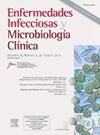Detection of carbapenemases in Enterobacterales susceptible in vitro to meropenem
IF 2.6
4区 医学
Q3 INFECTIOUS DISEASES
Enfermedades infecciosas y microbiologia clinica
Pub Date : 2025-01-01
DOI:10.1016/j.eimc.2024.07.015
引用次数: 0
Abstract
Introduction
Carbapenemase-producing Enterobacterales (CPE) is a global threat. We evaluate the prevalence of CPE among isolates categorized as meropenem-susceptible, but that meet the European Committee on Antimicrobial Susceptibility Testing (EUCAST) screening cut-off values for carbapenemase detection, and analyze the susceptibility of these isolates to new available drugs.
Methods
We analyzed 257 isolates from patients hospitalized in a tertiary hospital in Brazil, from July 2022 to April 2023. Only isolates that met the screening cut-off values established by EUCAST for detection of carbapenemases were analyzed (i.e. meropenem inhibition zones of 25–27 mm by disk diffusion). The detection of carbapenemases was performed by immnunochromatographic testing and confirmed by high-resolution melting-PCR (HRM-qPCR).
Results
We identified 12 (4.7%) CPE including 7 KPC, 4 NDM, and 1 OXA-48-like. The isolates were susceptible to ceftazidime–avibactam (72.7%), meropenem–vaborbactam (100%), imipenem–relebactam (63.6%) and ceftolozane–tazobactam (36.4%).
Conclusion
We highlight the importance of tracking carbapenemases for epidemiological control and therapeutic guidance.
美罗培南体外敏感肠杆菌中碳青霉烯酶的检测
产碳青霉烯酶肠杆菌(CPE)是一种全球性威胁。我们评估了被归类为美罗培尼敏感但符合欧洲抗微生物药物敏感性试验委员会(EUCAST)筛选碳青霉烯酶检测临界值的分离株中CPE的患病率,并分析了这些分离株对现有新药的敏感性。方法对2022年7月至2023年4月在巴西某三级医院住院的257株分离株进行分析。仅对符合EUCAST建立的碳青霉烯酶检测筛选临界值的分离株进行分析(即圆盘扩散法美罗培南抑制区为25-27 mm)。碳青霉烯酶采用免疫层析检测,高分辨率熔融pcr (HRM-qPCR)检测。结果共鉴定出12例(4.7%)CPE,包括7例KPC, 4例NDM和1例oxa -48样。对头孢他啶-阿维巴坦(72.7%)、美罗培恩-瓦波巴坦(100%)、亚胺培南-瑞巴坦(63.6%)和头孢洛赞-他唑巴坦(36.4%)敏感。结论碳青霉烯酶追踪对流行病学控制和治疗指导具有重要意义。
本文章由计算机程序翻译,如有差异,请以英文原文为准。
求助全文
约1分钟内获得全文
求助全文
来源期刊
CiteScore
2.10
自引率
8.00%
发文量
194
审稿时长
29 days
期刊介绍:
Hoy está universalmente reconocida la renovada y creciente importancia de la patología infecciosa: aparición de nuevos agentes patógenos, de cepas resistentes, de procesos con expresión clínica hasta ahora desconocida, de cuadros de una gran complejidad. Paralelamente, la Microbiología y la Infectología Clínicas han experimentado un gran desarrollo como respuesta al reto planteado por la actual patología infecciosa. Enfermedades Infecciosas y Microbiología Clínica es la Publicación Oficial de la Sociedad Española SEIMC. Cumple con la garantía científica de esta Sociedad, la doble función de difundir trabajos de investigación, tanto clínicos como microbiológicos, referidos a la patología infecciosa, y contribuye a la formación continuada de los interesados en aquella patología mediante artículos orientados a ese fin y elaborados por autores de la mayor calificación invitados por la revista.

 求助内容:
求助内容: 应助结果提醒方式:
应助结果提醒方式:


